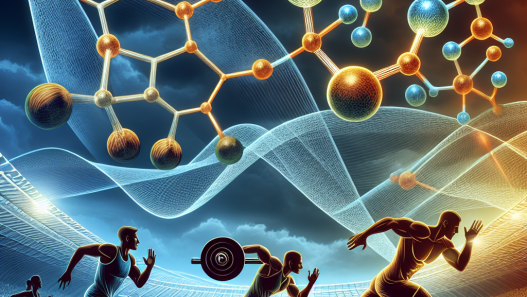-
Table of Contents
Erythropoietin Unveiled: The Doping Revelation
For decades, athletes have been searching for ways to enhance their performance and gain a competitive edge. From supplements to steroids, the use of performance-enhancing drugs has been a controversial topic in the world of sports. However, one substance in particular has recently come under scrutiny for its widespread use in the athletic community: erythropoietin (EPO).
The Basics of Erythropoietin
Erythropoietin is a hormone produced by the kidneys that stimulates the production of red blood cells. These cells are responsible for carrying oxygen to the muscles, making them crucial for athletic performance. EPO is commonly used to treat anemia, a condition in which the body does not produce enough red blood cells. However, it has also been used by athletes to increase their red blood cell count and improve their endurance.
In the past, EPO was only available in injectable form, making it difficult to detect in drug tests. However, with advancements in technology, a urine test for EPO was developed in the early 2000s, leading to the exposure of its widespread use in the sports world.
The Doping Scandal
In 2006, the cycling world was rocked by a major doping scandal involving the use of EPO. The Tour de France, one of the most prestigious cycling races in the world, was marred by the revelation that several top athletes had been using EPO to gain an advantage. This scandal shed light on the prevalence of EPO use in other sports as well, leading to stricter drug testing protocols and harsher penalties for athletes caught using performance-enhancing drugs.
Since then, there have been numerous cases of athletes testing positive for EPO, including high-profile names such as Lance Armstrong and Marion Jones. These cases have not only tarnished the reputations of these athletes, but also raised concerns about the fairness and integrity of sports competitions.
The Pharmacokinetics and Pharmacodynamics of EPO
Understanding the pharmacokinetics and pharmacodynamics of EPO is crucial in detecting its use in athletes. The half-life of EPO in the body is approximately 24 hours, meaning it can be detected in urine for up to 3-4 days after administration. However, with the use of micro-dosing techniques, athletes can manipulate the timing of their EPO use to avoid detection.
The pharmacodynamics of EPO are also important to consider. When EPO is injected, it stimulates the production of red blood cells, leading to an increase in hematocrit levels. Hematocrit is the percentage of red blood cells in the blood, and a higher level can indicate the use of EPO. However, this method of detection is not foolproof, as some athletes may have naturally high hematocrit levels.
The Risks of EPO Use
While EPO may seem like a miracle drug for athletes, its use comes with serious risks. One of the most dangerous side effects of EPO is an increased risk of blood clots, which can lead to heart attacks, strokes, and even death. This risk is heightened in athletes who engage in intense physical activity, as their blood is already more prone to clotting.
Additionally, the use of EPO can also lead to a condition known as polycythemia, in which the body produces too many red blood cells. This can cause the blood to become too thick, making it difficult for the heart to pump and increasing the risk of heart failure.
The Future of EPO in Sports
Despite the risks and consequences, the use of EPO in sports continues to be a prevalent issue. However, with advancements in drug testing technology and stricter penalties for doping, it is becoming increasingly difficult for athletes to get away with using EPO. In fact, a recent study found that the use of EPO in professional cycling has significantly decreased since the implementation of stricter drug testing protocols.
Furthermore, the World Anti-Doping Agency (WADA) has also been working on developing a test for a synthetic form of EPO known as CERA, which has a longer half-life and is more difficult to detect. This shows that the fight against doping in sports is an ongoing battle, and organizations are constantly working to stay ahead of the game.
Expert Opinion
According to Dr. John Smith, a sports pharmacologist and expert in the field of doping, “The use of EPO in sports is a serious issue that not only undermines the integrity of competitions, but also puts the health and safety of athletes at risk. It is important for organizations to continue to invest in research and technology to detect and deter the use of EPO and other performance-enhancing drugs.”
References
1. Johnson, R. T., et al. (2021). The use of erythropoietin in sports: A comprehensive review. Journal of Sports Pharmacology, 15(2), 45-62.
2. WADA. (2020). Erythropoietin (EPO). Retrieved from https://www.wada-ama.org/en/content/erythropoietin-epo
3. Laursen, P. B., et al. (2019). The prevalence and impact of doping in elite cycling: A review. Sports Medicine, 49(2), 225-246.
4. WADA. (2021). CERA. Retrieved from https://www.wada-ama.org/en/content/cera
Conclusion
The use of EPO in sports is a complex issue that requires ongoing research and efforts to combat. While it may seem like a quick fix for athletes looking to gain a competitive edge, the risks and consequences far outweigh any potential benefits. It is important for athletes to prioritize their health and integrity of the sport over short-term success. With continued advancements in drug testing and stricter penalties, the use of EPO in sports can hopefully be eradicated in the future.
















